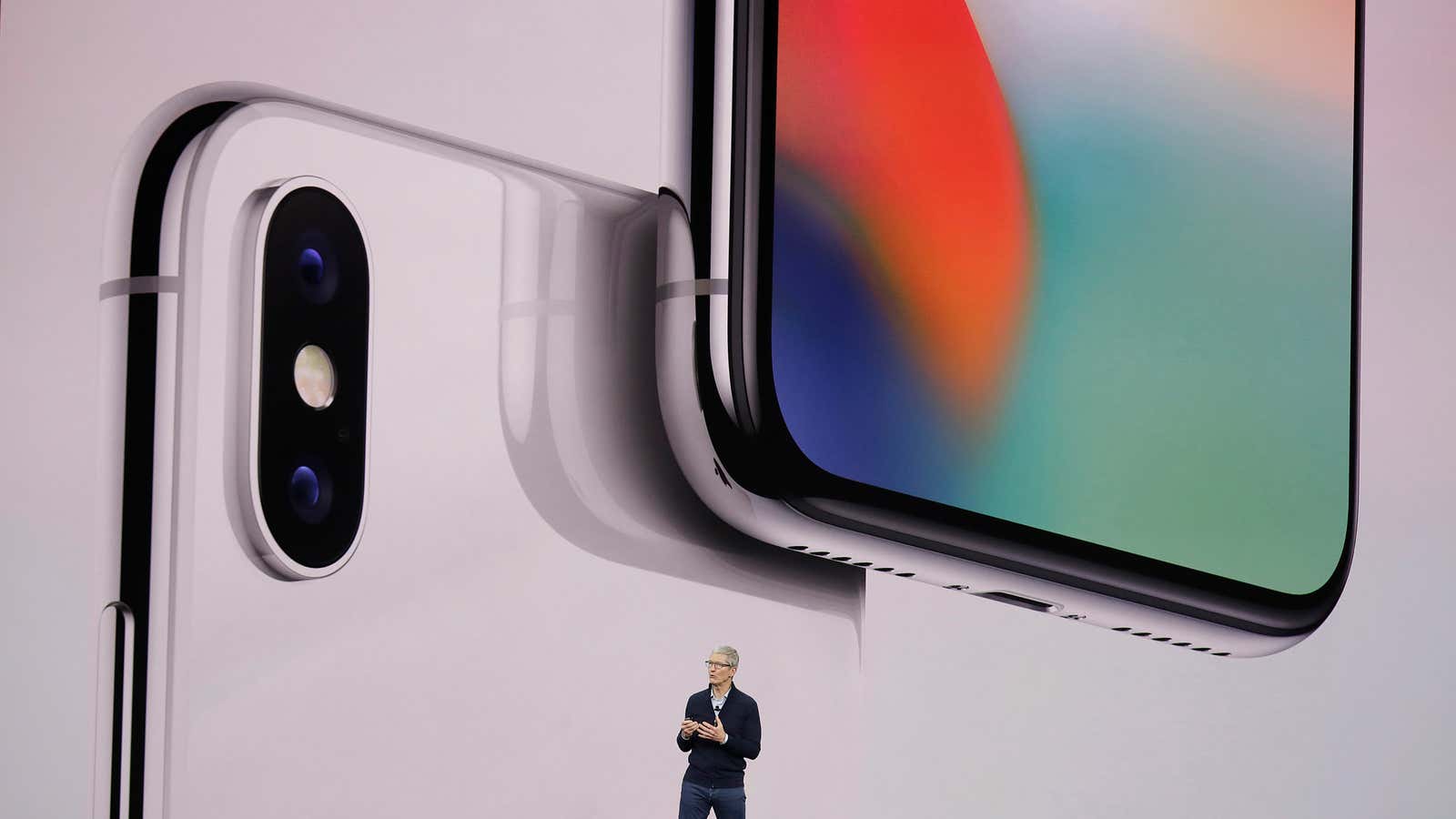When Apple reports its second-quarter earnings on May 1 (its financial year ends in December), investors will be looking for confirmation of CEO Tim Cook’s February promise: that the company’s $1,000 iPhoneX would set it up “for the next decade.”
The vast majority of Apple’s substantial revenue and profit comes from iPhone sales, and rumors of tepid demand for the iPhone X—its suppliers have let slip that orders are down—could be born out in earnings.
Apple’s last earnings report was another blockbuster, with record revenue and profit during the holiday quarter. The company’s stock price has fluctuated since then, predominantly due to the market’s growing fears around demand for the iPhone X. Traditionally, the second quarter is a relatively quiet one. Analysts are expecting Apple to generate about $61 billion in revenue, according to Bloomberg, which aligns with the $60 billion to $62 billion that the company forecast.
It’s possible that poor iPhone sales may be partially offset by the massive influx of cash Apple could soon share with investors. The company recently repatriated roughly $269 billion to the US, thanks to provisions in a tax cut boosted by president Donald Trump and signed by Congress in 2017. The company paid a (discounted) lump sum of $38 billion in taxes to bring back cash it held overseas, and some expect (paywall) that a large chunk of its now-taxed overseas funds will go into debt servicing, dividends, and stock buybacks.
After spending two years fighting lackluster sales growth, Apple returned to winning ways in late 2017. Whether that can be maintained with slowing iPhone X sales is the question. Look to see whether consumers are still buying other newer iPhone models, such as the 8 and 8 Plus, released just a month before the X, or if they’re holding off because they don’t see enough difference between the phones they have and those Apple has released recently.
Last quarter, the iPhone accounted for just under 70% of the company’s revenue, its largest slice ever. Part of that is thanks to sales of the pricey iPhone X model.
The average selling price of an iPhone skyrocketed last quarter because of the iPhone X. But at around $800, that average suggests many consumers were after a device closer in price to the iPhone 8 Plus, which starts at $700. Look to see if this number drops this quarter as more people choose less flashy but perhaps more affordable devices.
Apple’s biggest success story in recent years—beyond convincing us to continually purchase new phones that don’t act much different than their predecessors—is its Services business. This is pretty much everything digital that Apple sells: subscriptions to Apple Music and iCloud storage, games and apps, and music on the iTunes Store, along with AppleCare services. It’s grown to the size of a Fortune 100 company on its own. Services has broken out of Apple’s generally cyclical sales cycle, growing for the past four quarters in a row, and generating more than $31 billion in revenue over that period.
To keep users locked into its world, Apple plans to add even more content to its devices, including more original TV programming. There’s even talk of the company taking over parts or all of Condé Nast, which owns magazines such as Wired, Vogue, Bon Appétit, and The New Yorker. Look to see if Apple can keep its services momentum going, which will likely soften any blows from tepid iPhone X sales.
In March, Apple announced a new iPad and education-focused software updates intended to help it compete in a market that it has effectively ceded to Google and Microsoft. iPad sales have crept back up in recent quarters, but have fallen below sales of Apple’s more recently updated computer devices, including the MacBook and iMac lines. The tablet was supposed to be the end of the PC market as we know it, but innovation in the space has stalled, and the PC market actually grew this holiday season for the first time in six years. Apple’s computer business has remained relatively static, while its PC competitors have grown, so look for indications from Cook as to whether the company’s focus is still on the iPad.
Apple’s other main revenue drivers are the Apple Watch and AirPods wireless earbuds, which are dumped into a business line called “Other Products” that also houses accessories and Beats headphones. Since releasing it in early 2015, Apple has refused to break out sales of the Apple Watch, which was the first major product launched under Cook. After an initial spike in 2015, Other Products cooled off as it seemed consumers weren’t wearing their Apple Watches, let alone buying new ones. But since the Apple Watch Series 3, which went on sale in September, the business line’s growth has skyrocketed. Look for a continuation of that momentum and any indication of the health of the AirPods business.
The Americas is Apple’s largest sales region, followed distantly by Europe. The company has faced resistance to expansion efforts in India and China, from middle-class consumers who don’t see the value in Apple’s more expensive products, consumers who can’t afford them, and local authorities (paywall). Apple has tried to re-release or modify older models for these markets, so far with little success.
